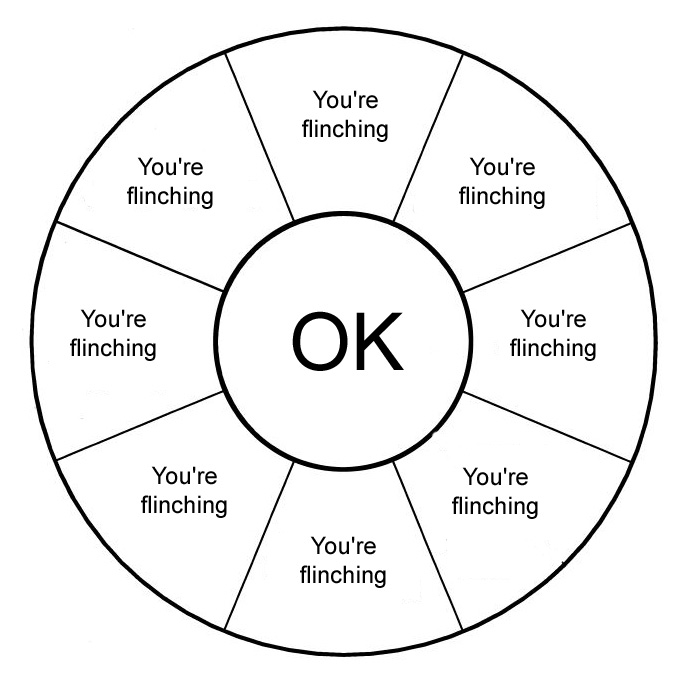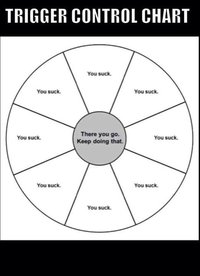Dagnabbit...shooting low and left with my new Ruger LC9S. I know it is me and not the gun. What is so frustrating is that I can shoot my Ruger SR22 with tremendous accuracy. I have dry fired the LC9S many a time. Wife even puts the old dime coin on the front sight trick and I have no problem. I know about jerking the trigger and the right amount of index finger on the trigger. I also know it's me because I have shot the LC9S using a good handgun rest and I can shoot well using the rest. So...do these guns naturally want to dull down and left when shooting them? Do I have to fight that force or is it still me jerking the trigger or what? Thanks all!
-
If you enjoy the forum please consider supporting it by signing up for a NES Membership The benefits pay for the membership many times over.
You are using an out of date browser. It may not display this or other websites correctly.
You should upgrade or use an alternative browser.
You should upgrade or use an alternative browser.
Shooting Low Left
- Thread starter jkon
- Start date
I had this problem when I first started shooting glocks, changed my sight picture to have the center of the front dot aligned with the top of the rear sight and also shooting with both eyes open focused on the target and the front sight blurry and covering the target. Works perfect for me, I just wait for the muzzle to settle back onto the target and squeeze another off, I can do fast consistent accurate mag dumps this way.
Yes its you, are you anticipating the shot ? Trigger flinch , keep working at it.Dagnabbit...shooting low and left with my new Ruger LC9S. I know it is me and not the gun. What is so frustrating is that I can shoot my Ruger SR22 with tremendous accuracy. I have dry fired the LC9S many a time. Wife even puts the old dime coin on the front sight trick and I have no problem. I know about jerking the trigger and the right amount of index finger on the trigger. I also know it's me because I have shot the LC9S using a good handgun rest and I can shoot well using the rest. So...do these guns naturally want to dull down and left when shooting them? Do I have to fight that force or is it still me jerking the trigger or what? Thanks all!
You're anticipating/pushing. Get some dummy rounds, mix them in the mag with live rounds. Slow fire, watch the sights, and you'll see the flinch when the dummy get chambered. Once you get confirmation get over it mentally and you'll shoot better.
You're anticipating/pushing. Get some dummy rounds, mix them in the mag with live rounds. Slow fire, watch the sights, and you'll see the flinch when the dummy get chambered. Once you get confirmation get over it mentally and you'll shoot better.
Yup.
Also, get a rifle rest. Put the rest on a bench, the handgun on the rest, and slow fire.
Dagnabbit...shooting low and left with my new Ruger LC9S. I know it is me and not the gun. What is so frustrating is that I can shoot my Ruger SR22 with tremendous accuracy. I have dry fired the LC9S many a time. Wife even puts the old dime coin on the front sight trick and I have no problem. I know about jerking the trigger and the right amount of index finger on the trigger. I also know it's me because I have shot the LC9S using a good handgun rest and I can shoot well using the rest. So...do these guns naturally want to dull down and left when shooting them? Do I have to fight that force or is it still me jerking the trigger or what? Thanks all!
It's you but I'd say your experience isn't unique. I've had to work at it with my LC9s to avoid a flinch. I recently got an iPhone 6 which does 240fps slowmo video. I put it on a tripod and filmed drills with my LC9s. Sure enough the rounds that go low are all me dropping the muzzle at the last possible second. It happens in the 100th of a second before the trigger breaks.
Just like you, I dry fire at home and I'm dead steady. That trigger is epic so it's not hard. The gun is just snappy. It's the weight of a .22LR pistol with the energy of a 9 recoiling against it. That causes a flinch. You don't do this with the SR22 because its recoil and blast are mild, so there's no anticipation.
If you have access to a smart phone with high speed video, I suggest diagnosing with that. Aside from that it's just a mental thing. I suggest loading only one round and making it all about that one round. Focus on an overly slow trigger squeeze, constantly focusing on your sight alignment through a surprise trigger break. Focus on allowing the gun to recoil up, and not trying to force the muzzle back down to target. Once you hone the single shot accuracy, you'll be able to get back into follow up shots and faster shooting with more success.
You're anticipating/pushing. Get some dummy rounds, mix them in the mag with live rounds. Slow fire, watch the sights, and you'll see the flinch when the dummy get chambered. Once you get confirmation get over it mentally and you'll shoot better.
Couldn't have said it any better than this. I do this all the time. If you have a universal bore sighter laser put that in, with the gun unloaded. And practice dry firing. You will see how much you flinch/pull the gun with the laser on the wall.
You're anticipating/pushing. Get some dummy rounds, mix them in the mag with live rounds. Slow fire, watch the sights, and you'll see the flinch when the dummy get chambered. Once you get confirmation get over it mentally and you'll shoot better.
This ^^^^
I started having the same problem out of the blue about a year ago. Went through a couple of weeks of pushing all of my pistols around, generally low left. I did the aforementioned therapy, found the flinch and eradicated it.
I'm sorry, but I think that chart is crap. This is the only one that I think makes sense:

That'll work. Instead of "You suck", perhaps it would be better if it said "Stop being a pussy"
![Wink [wink] [wink]](/xen/styles/default/xenforo/smilies.vb/002.gif)
I'm sorry, but I think that chart is crap. This is the only one that I think makes sense:

lol, I agree with this chart. As Derek said above, snap caps are great but only when you don't know they are there. I load a few mags at a time mixing snap caps in so I never know exactly where they are. Or just have my wife load the mags but she usually wants to shoot not load mags.
lol, I agree with this chart. As Derek said above, snap caps are great but only when you don't know they are there. I load a few mags at a time mixing snap caps in so I never know exactly where they are. Or just have my wife load the mags but she usually wants to shoot not load mags.
That and dry firing. Lots and lots of dry firing.
That and dry firing. Lots and lots of dry firing.
I find that dry firing doesn't help my flinch as much as the snap caps do. Want to see a great flinch? Throw a few snap caps in then do some rapid fire exercises like "Bill Drills". You will yank the snot out of that trigger the first time! You may not think you are yanking the trigger but when you see that, man is it obvious.
There are two types of flinching, IMHO. There's the HOLDY **** THIS THING EXPLODED IN FRONT OF MY FACE kind of fear flinch and theres the "omg im going too slow I gotta speed up" flinch which can come and go in waves, etc.
The 2nd type is not nearly as bad as the first but it's still there. And it's still a problem.
-Mike
The 2nd type is not nearly as bad as the first but it's still there. And it's still a problem.
-Mike
There are two types of flinching, IMHO. There's the HOLDY **** THIS THING EXPLODED IN FRONT OF MY FACE kind of fear flinch and theres the "omg im going too slow I gotta speed up" flinch which can come and go in waves, etc.
The 2nd type is not nearly as bad as the first but it's still there. And it's still a problem.
-Mike
Yep. The second one is the type I keep working on. I find if I do a drill like 5 shots, mag change, 5 shots, the first 5 go right where they should, then the 5 after the mag change are erratic. Reasoning being the subconscious sense of "crap I paused, now I need to catch up".
There are two types of flinching, IMHO. There's the HOLDY **** THIS THING EXPLODED IN FRONT OF MY FACE kind of fear flinch and theres the "omg im going too slow I gotta speed up" flinch which can come and go in waves, etc.
The 2nd type is not nearly as bad as the first but it's still there. And it's still a problem.
-Mike
I would say anticipating recoil is a form of flinching not covered in either of those and has little to do with "fear of exploding in my face". Even the best shooters anticipate recoil and have to work very hard to neutralize a natural response to recoil.
- Joined
- Apr 20, 2013
- Messages
- 3,632
- Likes
- 2,422
A flinch can be many things, but low left is jerking the trigger. To shoot well, grip and stance are important but sight alignment and trigger pull are more important. Learn to shoot it well slow fire and then go for speed. You should focus on the front sight. Decide where to hold on the target (center or six o'clock) and adjust your sights or your load to get the bullets to hit where you want. If you have fixed sights, higher speed, lighter bullets in a handgun will hit lower because they exit the barrel quicker and are less affected by muzzle jump in recoil. A six o'clock hold is easier to shoot well as the bull floats above the front sight. You might argue that the gun is for defense and you want your sights "centered" so you should hold center bull. That is understandable. Just hold six o'clock and adjust it so the bullets hit at the bottom of the bull. (Point of aim with a good aiming point.) You want a good group, and not a good score. The sights will move around on the target. You have to accept some movement and try to increase the pressure on the trigger when the sights look "good" until the gun fires. You should be a little surprised when the trigger breaks. As long as the sights were aligned, you will hit within your circle of movement. Make sure you don't yank the trigger when the sights look perfect as that will open up the group a lot causing the low left hits. Remember, front sight and squeeze the trigger. When you are good at slow fire, just squeeze faster... ![Wink [wink] [wink]](/xen/styles/default/xenforo/smilies.vb/002.gif)
![Wink [wink] [wink]](/xen/styles/default/xenforo/smilies.vb/002.gif)
To shoot well, grip and stance are important but sight alignment and trigger pull are more important.
I'll disagree a bit. Stance is unimportant. Completely.
A couple years back I took a class with Ben Stoeger, a Grand Master in USPSA. I believe he was Production champion last year. He jumped up and down on one foot while rapidly firing six rounds into the A-zone of a USPSA target about 10 yards away.
Sight alignment and trigger pull are vital for hitting your target. Grip is important for speed of followup shots. But stance? Nope. Not important.
Look, you're probably afraid of the recoil and BANG that's going to happen. Just relax and realize it won't hurt you. Just squeeze gently, like you're squeezing a new born kitten and be one with your target. The bad thing happens at the other end, not your end. Your end is the happy end.
- Joined
- Apr 20, 2013
- Messages
- 3,632
- Likes
- 2,422
Yes, but what direction was his foot pointing... once he got it right, he jumped up and down.I'll disagree a bit. Stance is unimportant. Completely.
A couple years back I took a class with Ben Stoeger, a Grand Master in USPSA. I believe he was Production champion last year. He jumped up and down on one foot while rapidly firing six rounds into the A-zone of a USPSA target about 10 yards away.
Sight alignment and trigger pull are vital for hitting your target. Grip is important for speed of followup shots. But stance? Nope. Not important.
![Wink [wink] [wink]](/xen/styles/default/xenforo/smilies.vb/002.gif) Try this, spuare up to a "target" and move your right foot to the front and to the back. It translates to left and right on the target. Your arms can compensate but there is a neutral position where they don't have to...
Try this, spuare up to a "target" and move your right foot to the front and to the back. It translates to left and right on the target. Your arms can compensate but there is a neutral position where they don't have to...Chevy 2 65
NES Member
Happened to me. Do what Derek said, it worked for meDagnabbit...shooting low and left with my new Ruger LC9S. I know it is me and not the gun. What is so frustrating is that I can shoot my Ruger SR22 with tremendous accuracy. I have dry fired the LC9S many a time. Wife even puts the old dime coin on the front sight trick and I have no problem. I know about jerking the trigger and the right amount of index finger on the trigger. I also know it's me because I have shot the LC9S using a good handgun rest and I can shoot well using the rest. So...do these guns naturally want to dull down and left when shooting them? Do I have to fight that force or is it still me jerking the trigger or what? Thanks all!
Cloverleaf Firearms Group
Instructor
Yes, but what direction was his foot pointing... once he got it right, he jumped up and down.Try this, spuare up to a "target" and move your right foot to the front and to the back. It translates to left and right on the target. Your arms can compensate but there is a neutral position where they don't have to...
Probably not. Once he started moving, it was timing that drove his success at the task.
I'll disagree a bit. Stance is unimportant. Completely.
A couple years back I took a class with Ben Stoeger, a Grand Master in USPSA. I believe he was Production champion last year. He jumped up and down on one foot while rapidly firing six rounds into the A-zone of a USPSA target about 10 yards away.
Sight alignment and trigger pull are vital for hitting your target. Grip is important for speed of followup shots. But stance? Nope. Not important.
The most amazing part... it was with a Beretta.
OP - accept the fact that you're not holding the sights on target until the shot breaks. Figure out why. For me, it's usually because I'm squeezing all the fingers of my strong hand instead of isolating the trigger finger, and not gripping hard enough with my weak hand.
Yes, but what direction was his foot pointing... once he got it right, he jumped up and down.Try this, spuare up to a "target" and move your right foot to the front and to the back. It translates to left and right on the target. Your arms can compensate but there is a neutral position where they don't have to...
You're still fixated on being in a certain, still position while making your shots. One of the great things about action shooting is learning to make shots on the move, while off balance, and in contorted positions.
Having seen Stoeger shoot, I'm sure he could have made those shots if we was swinging his foot back and forth.
Is stance a big part of bullseye and getting the absolutely smallest group possible? Sure. But for watch a top notch action shooter and you'll see they are quite accurate even though they are often moving or in awkward positions.
- - - Updated - - -
The most amazing part... it was with a Beretta.
![ROFL [rofl] [rofl]](/xen/styles/default/xenforo/smilies.vb/013.gif)
He has since defected and bought up all the Tangfo Stock IIs in the country.
Last edited:
Glockster30
NES Member
Let's face it though. Most of the top shooters shoot anywhere from 50k to 150k rounds per year. How many of us can afford to shoot 1k/wk (52,000/yr)? In addition, I think that I read that Ben Stoeger practiced dry firing two hours a day. Again, how many of us have the time to train that hard? For shooting and training, the average person just doesn't have the time and money to become a top shooter.
Share:



